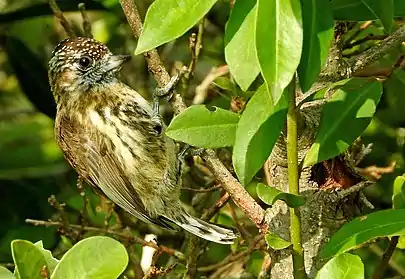Mottled piculet
The mottled piculet (Picumnus nebulosus) is a species of bird in the family Picidae. It is found in north eastern Argentina, south eastern Brazil, and Uruguay. Its natural habitat is subtropical or tropical moist lowland forests. It is becoming rare due to habitat loss.
| Mottled piculet | |
|---|---|
 | |
| Adult male at Urupema, Santa Catarina state, Brazil | |
| Scientific classification | |
| Kingdom: | Animalia |
| Phylum: | Chordata |
| Class: | Aves |
| Order: | Piciformes |
| Family: | Picidae |
| Genus: | Picumnus |
| Species: | P. nebulosus |
| Binomial name | |
| Picumnus nebulosus Sundevall, 1866 | |
Description
Adult mottled piculets are from 10 to 11 cm (3.9 to 4.3 in) long. The crown, cheeks and chin are speckled in black and white, with a larger patch of white behind the eye. The crown is often tufted, and in males the fore-crown may form a red patch or there may be a few red-tipped feathers. Other than this, the sexes are alike. The back of the head, nape and neck are buff or brown. The mantle and back are rusty brown and the wings are brown, with pale edges to the feathers. The two central tail feathers are white and the remaining tail feathers are black, with some white streaks on the outer ones. The breast, belly and flanks are rusty brown, boldly streaked and mottled with black. The eye is brown, the orbital ring grey, the beak blackish and the legs grey. Juveniles are similar to the female apart from a chocolate brown fore-crown and less streaking on the underparts.[2]

Distribution and habitat
The mottled piculet is endemic to southeastern South America. Its range extends from southeastern Brazil and southeastern Paraguay to Uruguay and northeastern Argentina. It is mainly a lowland species, ranging up to about 1,400 m (4,600 ft). Its typical habitat is Atlantic forest and Araucaria forest, but it also occurs in secondary forest, bamboo thickets, scrubland and wooded savannah.[2]
Behaviour
Vocalisations are limited to a repetitive "seep" or "cheep", sometimes linked into a brief trill, and an occasional humming sound. The alarm call is a shrill cricket-like whistling sound. The bird also drums, particularly on bamboo, in an irregular pattern of two to four rapid strikes.[2] Little is known of its feeding habits, but it sometimes forages in small mixed flocks through the understorey, among vines, tangled growth and bamboo stems, presumably looking for small invertebrates.[2]
Piculets nest in holes in trees. The mottled piculet breeds between October and December, but little is known of its breeding habits. It is generally an uncommon species with a patchy distribution and is listed as being a "near-threatened species".[3]
References
- BirdLife International (2012). "Picumnus nebulosus". IUCN Red List of Threatened Species. 2012. Retrieved 26 November 2013.CS1 maint: ref=harv (link)
- Gorman, Gerard (2014). Woodpeckers of the World: A Photographic Guide. Firefly Books. pp. 80–81. ISBN 177085309X.
- Winkler, H.; Christie, D.A.; Bonan, A. (2019). "Mottled Piculet (Picumnus nebulosus)". Handbook of the Birds of the World Alive. Lynx Edicions, Barcelona. Retrieved 19 March 2019.
